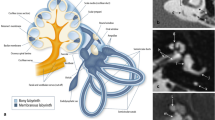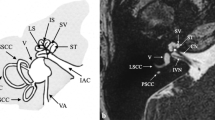Abstract
The purpose of the study was to obtain reference values for the sizes of anatomical structures of the inner ear on computed tomography (CT) images and to compare these values with those obtained from patients with Menière’s disease. CT images of the temporal bone of 67 patients without inner ear pathology and 53 patients with Menière’s disease have been evaluated. CT was performed in the sequential mode (1-mm slice thickness, 120 kV, 125 mA). Anatomical structures, such as the length and the width of the cochlea and of the vestibule, the height of the basal turn, the length and the width of the cochlear, the vestibular and the singular aqueduct and the internal auditory meatus and the diameter of the semicircular canals, were measured, using a dedicated postprocessing workstation. Reference values from the control group could be obtained. In the patients with Menière’s disease, the length and the width of the vestibular aqueduct were smaller, compared with the values from the control group. The values obtained from the control group can serve as reference values for adult patients. The different sizes of anatomical structures of the control group and of patients suffering from Menière’s disease suggest that functional impairment might be related to subtle morphological changes.





Similar content being viewed by others
References
Yuen HY, Ahuja AT, Wong KT, Yue V, van Hasselt AC (2003) Computed tomography of common congenital lesions of the temporal bone. Clin Radiol 58:687–693
Lemmerling MM, Mancuso AA, Antonelli PJ, Kubilis PS (1997) Normal modiolus: CT appearance in patients with a large vestibular aqueduct. Radiology 204:213–219
Purcell DD, Fischbein N, Lalwani AK (2003) Identification of previously “undetectable” abnormalities of the bony labyrinth with computed tomography measurement. Laryngoscope 113:1908–1911
Madden C, Halsted M, Benton C, Greinwald J, Choo D (2003) Enlarged vestibular aqueduct syndrome in the pediatric population. Otol Neurol 24:625–632
Krombach GA, Schmitz-Rode T, Prescher A, DiMartino E, Weidner J, Gunther RW (2002) The petromastoid canal on computed tomography. Eur Radiol 12:2770–2775
Lang J, Hack C (1987) Canal systems in the temporal bone and their right-left differences. Acta Anat (Basel) 130:298–308
Lang J, Hack C (1985) Position and variations in the position of the canal system in the temporal bone. I. The canals of the pars petrosa between the margo superior and the meatus acusticus internus. HNO 33:176–179
Lang J, Stober G (1987) Position and position variations of the canal system of the temporal bone in frontal section. Gegenbaurs Morphol Jahrb 133:249–289
Maher N, Becker H, Laszig R (1995) Quantification of relevant measurements of the petrous bone with computerized tomography before cochlear implant operation. Laryngorhinootologie 74:337–342
Purcell D, Johnson J, Fischbein N, Lalwani AK (2003) Establishment of normative cochlear and vestibular measurements to aid in the diagnosis of inner ear malformations. Otolaryngol Head Neck Surg 128:78–87
Soderman AC, Moller J, Bagger-Sjoback D, Bergenius J, Hallqvist J (2004) Stress as a trigger of attacks in Meniere’s disease. A case-crossover study. Laryngoscope 114:1843–1848
Naganawa S, Koshikawa T, Nakamura T, Fukatsu H, Ishigaki T, Aoki I (2003) High-resolution T1-weighted 3D real IR imaging of the temporal bone using triple-dose contrast material. Eur Radiol 13:2650–2658
Naganawa S, Koshikawa T, Fukatsu H, Ishigaki T, Nakashima T (2002) Serial MR imaging studies in enlarged endolymphatic duct and sac syndrome. Eur Radiol 12(Suppl 3):S114-S117
Naganawa S, Koshikawa T, Fukatsu H, Ishigaki T, Nakashima T, Ichinose N (2002) Contrast-enhanced MR imaging of the endolymphatic sac in patients with sudden hearing loss. Eur Radiol 12:1121–1126
Sando I, Ikeda M (1984) The vestibular aqueduct in patients with Meniere’s disease. A temporal bone histopathological investigation. Acta Oto-laryngol 97:558–570
Sennaroglu L, Yilmazer C, Basaran F, Sennaroglu G, Gursel B (2001) Relationship of vestibular aqueduct and inner ear pressure in Meniere’s disease and the normal population. Laryngoscope 111:1625–1630
Stahle J, Wilbrand H (1974) The vestibular aqueduct in patients with Meniere’s disease. A tomographic and clinical investigation. Acta Oto-laryngol 78:36–48
Yazawa Y, Kitahara M (1991) Computed tomographic findings around the vestibular aqueduct in Meniere’s disease. Acta Oto-laryngol, Suppl 481:88–90
Yazawa Y, Kitahara M (1994) Computerized tomography of the petrous bone in Meniere’s disease. Acta Oto-laryngol, Suppl 510:67–72
Mark AS, Fitzgerald D (1997) Endolymphatic duct/sac enhancement on gadolinium magnetic resonance imaging of the inner ear: preliminary observations and case reports. Am J Otol 18:535
Okumura T, Takahashi H, Honjo I et al (1995) Vestibular function in patients with a large vestibular aqueduct. Acta Oto-laryngol, Suppl 520(Pt 2):323–326
Okumura T, Takahashi H, Honjo I, Takagi A, Azato R (1996) Magnetic resonance imaging of patients with large vestibular aqueducts. Eur Arch Oto-rhino-laryngol 253:425–428
Acknowledgement
We thank Claudia Weiss from the Institute for Medical Statistics for assistance with the statistical analysis.
Author information
Authors and Affiliations
Corresponding author
Rights and permissions
About this article
Cite this article
Krombach, G.A., van den Boom, M., Di Martino, E. et al. Computed tomography of the inner ear: size of anatomical structures in the normal temporal bone and in the temporal bone of patients with Menière’s disease. Eur Radiol 15, 1505–1513 (2005). https://doi.org/10.1007/s00330-005-2750-9
Received:
Revised:
Accepted:
Published:
Issue Date:
DOI: https://doi.org/10.1007/s00330-005-2750-9




